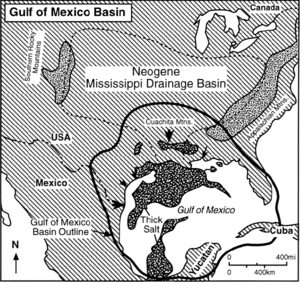Difference between revisions of "Basin outline: Gulf of Mexico example"
FWhitehurst (talk | contribs) |
Cwhitehurst (talk | contribs) m (added Category:Treatise Handbook 3 using HotCat) |
||
| (8 intermediate revisions by 3 users not shown) | |||
| Line 6: | Line 6: | ||
| part = Critical elements of the petroleum system | | part = Critical elements of the petroleum system | ||
| chapter = Sedimentary basin analysis | | chapter = Sedimentary basin analysis | ||
| − | | frompg = 4- | + | | frompg = 4-8 |
| − | | topg = 4- | + | | topg = 4-8 |
| author = John M. Armentrout | | author = John M. Armentrout | ||
| link = http://archives.datapages.com/data/specpubs/beaumont/ch04/ch04.htm | | link = http://archives.datapages.com/data/specpubs/beaumont/ch04/ch04.htm | ||
| Line 16: | Line 16: | ||
==Discussion== | ==Discussion== | ||
| − | [[file:sedimentary-basin-analysis_fig4-2.png|thumb|300px|{{figure number|1}}Geographic distribution of the Neogene Mississippi River drainage basin and distribution of the primary fluvial input systems (arrows). Modified after Winker and Buffler.<ref name=ch04r116>Winker, C., D., | + | [[file:sedimentary-basin-analysis_fig4-2.png|thumb|300px|{{figure number|1}}Geographic distribution of the Neogene Mississippi River drainage basin and distribution of the primary fluvial input systems (arrows). Modified after Winker and Buffler.<ref name=ch04r116>Winker, C., D., and R .T. Buffler, 1988, [http://archives.datapages.com/data/bulletns/1988-89/data/pg/0072/0003/0300/0318.htm Paleogeographic evolution of the early deep-water Gulf of Mexico and its margins, Jurassic to middle Cretaceous (Comanchean)]: AAPG Bulletin, vol. 72, p. 318–346.</ref>]] |
| − | The [[Gulf of Mexico (GOM | + | The [[Gulf of Mexico]] (GOM) basin includes strata beneath the present-day Gulf of Mexico and extends onshore beneath the coastal plain of Mexico and the United States. Sediment is supplied primarily by [[fluvial]] systems draining the ancestral Mississippi River system and smaller river systems draining the [[Rocky Mountains|Rocky]], [[Ouachita Mountains|Ouachita]], and [[Appalachian Mountains|Appalachian]] mountain ranges. Lesser amounts of [[carbonate]] sediments are produced locally by [[biochemical processes]]. Critical to the understanding of the GOM basin history and the associated [[petroleum system]]s of the northern Gulf of Mexico is the interaction of the [[Cretaceous]]-[[Holocene]] [[Mississippi drainage basin]] and thick [[salt]] deposited during the [[Jurassic]]. |
| − | [[:file:sedimentary-basin-analysis_fig4-2.png|Figure 1]] shows the geographic distribution of the [[Neogene]] Mississippi River drainage basin and distribution of the primary fluvial input systems (arrows). It also shows the interpreted limits of thick Jurassic salt (>1.5 km). The geographic shifts of primary fluvial input have resulted in [[depocenter]]s of different ages across the GOM Paleogene basin. | + | [[:file:sedimentary-basin-analysis_fig4-2.png|Figure 1]] shows the geographic distribution of the [[Neogene]] Mississippi River drainage basin and distribution of the primary fluvial input systems (arrows). It also shows the interpreted limits of thick Jurassic salt (>1.5 km). The geographic shifts of primary fluvial input have resulted in [[depocenter]]s of different ages across the GOM [[Paleogene]] basin. |
==See also== | ==See also== | ||
| − | |||
* [[How to define the framework of a basin]] | * [[How to define the framework of a basin]] | ||
* [[Example: mapping sediment thickness and field location]] | * [[Example: mapping sediment thickness and field location]] | ||
| Line 38: | Line 37: | ||
[[Category:Critical elements of the petroleum system]] | [[Category:Critical elements of the petroleum system]] | ||
[[Category:Sedimentary basin analysis]] | [[Category:Sedimentary basin analysis]] | ||
| + | [[Category:Treatise Handbook 3]] | ||
Latest revision as of 17:53, 18 February 2022
| Exploring for Oil and Gas Traps | |

| |
| Series | Treatise in Petroleum Geology |
|---|---|
| Part | Critical elements of the petroleum system |
| Chapter | Sedimentary basin analysis |
| Author | John M. Armentrout |
| Link | Web page |
| Store | AAPG Store |
Discussion

The Gulf of Mexico (GOM) basin includes strata beneath the present-day Gulf of Mexico and extends onshore beneath the coastal plain of Mexico and the United States. Sediment is supplied primarily by fluvial systems draining the ancestral Mississippi River system and smaller river systems draining the Rocky, Ouachita, and Appalachian mountain ranges. Lesser amounts of carbonate sediments are produced locally by biochemical processes. Critical to the understanding of the GOM basin history and the associated petroleum systems of the northern Gulf of Mexico is the interaction of the Cretaceous-Holocene Mississippi drainage basin and thick salt deposited during the Jurassic.
Figure 1 shows the geographic distribution of the Neogene Mississippi River drainage basin and distribution of the primary fluvial input systems (arrows). It also shows the interpreted limits of thick Jurassic salt (>1.5 km). The geographic shifts of primary fluvial input have resulted in depocenters of different ages across the GOM Paleogene basin.
See also
- How to define the framework of a basin
- Example: mapping sediment thickness and field location
- Example: mapping hydrocarbon types
References
- ↑ Winker, C., D., and R .T. Buffler, 1988, Paleogeographic evolution of the early deep-water Gulf of Mexico and its margins, Jurassic to middle Cretaceous (Comanchean): AAPG Bulletin, vol. 72, p. 318–346.